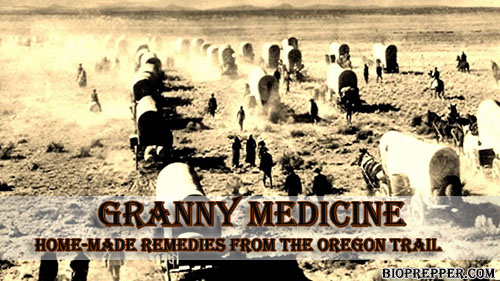Settlers relied on “ granny medicine ” or home remedies passed from mother to daughter over the years.

Families also put their faith in books such as “The Family Nurse” and “Gunn’s Domestic Medicine” or the “Poor Man’s Friend. Emigrants that traveled along the Oregon and California Trails had no real understanding of the nature of disease. They did, however, appreciate its effects. Epidemics tore through the country every few years, aided in their spread by improvements in transportation — every new road, canal, steamboat, clipper ship and railroad line was a potential route for a local outbreak to spread into an epidemic. Children were at risk from illnesses such as scarlet fever and diphtheria, which are all but forgotten in the United States today. Tuberculosis, known as “consumption,” slowly wore down its victims and over the course of many years was so common that a deep hacking cough was almost a badge of old age, like wrinkles or gray hair. Malaria was such a major barrier to settlers along the upper Mississippi that some medical experts of the day declared that parts of Illinois, Iowa and Missouri would probably never be permanently settled.
While cholera was the most widely feared disease among the over-landers, tens of thousands of people emigrated to Oregon and California over the course of a generation, and they brought along virtually every disease and chronic medical condition known to science. Dysentery, small pox, measles, mumps and influenza were among the diseases named in diaries and journals of these travelers, but cholera, mountain fever and scurvy were the biggest killers.
Cholera had its worst reputation in the 1800s. It raged across the planet every few years in a series of outbreaks that killed millions. Our present day anxiety about some horrible disease being spread rapidly around the world by modern transportation has already happened to devastating effect in recent history like Ebola being spread from Africa aboard jet aircraft. Back then it was cholera that journeyed around the world aboard sailing ships. If cholera didn’t prove lethal in the first 24 hours it would probably run its course in 5 to 7 days.
Disease was the single biggest threat to the emigrants on the overland trails, but overlanders had to deal with accidental injuries as well. Horses and oxen sometimes bit or kicked their owners; people occasionally slipped as they were climbing on or off their wagons and were run over; and there were even a handful of people struck by lightning over the years. Among the most difficult injuries to treat were gunshot wounds, where little could be done beyond bandaging the wound and relieving pain. Most gunshot wounds were caused by carelessness or lack of experience with firearms.
Cures for common illnesses such as burns, common cold, snakebite and syphilis were treated by “ granny medicine ”
Granny medicine – Home-made remedies from the OREGON TRAIL
Burns — Coat the burned skin with egg white, as this provided a sterile seal for the skin and helped keep the wound from drying out. Some folks on the Oregon Trail had to use axle grease, which was made of rendered animal fat and a bit of beeswax thinned with turpentine. That just seems like it would hurt more than the burn itself.
The Common Cold — A few drops of camphor in a glass of hot water was recommended, and for a sore throat, tie a piece of bacon sprinkled with black pepper around the patients’ neck. I’m not sure you should try this if you have a dog.
Cough Syrup — Take poplar bark and bethroot, boil for 20 minutes, drain, add sugar and simmer till the scum ceases to rise. They lost me at scum.
Diarrhea — A standard treatment was an hourly spoonful of water in which blackberry root had been boiled. Doesn’t too many blackberries cause diarrhea?
Snakebite — Rattlesnake bites were often treated just like you see in old westerns; somebody would slice open the bite wound and suck the poison out. This was actually fairly effective if done right away.
Syphilis — The standard heroic treatment for centuries was mercury. Long-term use was thought to be dangerous though. Grannies often recommended arsenic as a safer alternative. I think what Granny was actually saying is that it’s better to be dead than have syphilis.
Tuberculosis — The settlers had many treatments for tuberculosis, none of which were effective. Among them were smoking tobacco, drinking cod liver oil and eating a thick, boiled-down onion stew. Because that makes sense.
The Summer Complaint — Though widely believed to be the result of heat interfering with digestion, “the summer complaint” was simply food poisoning. Between the lack of refrigeration and ignorance of the existence of germs, nobody gave much thought to handling food (especially meat) safely. Little wonder that food poisoning was so common during the warm months of the year that it was thought to be a seasonal disease. Another thing to be grateful for: refrigerators.
Here’s what the pioneers used for pain!
Don’t let this knowledge get lost.Find all the wisdom of our ancestors in this great book ”The Lost Ways”. Get your hard cover copy now!
They say there was a certain amount of common sense in Granny Medicine. For example, one basic rule was that anything that had some sort of noticeable effect on the body must have medicinal value. Peppermint oil was used to treat all manner of aches and pains because it causes a sensation of warmth when applied to the skin, and asparagus was widely thought to be good for the kidneys because it makes urine smell odd.
Must-have medicines when traveling over the Plains included:
Essence of peppermint — was used to cure stomach aches and likely actually worked.
Pine tar and turpentine — was used for coughing due to dust, and may have worked if small enough quantities were taken.
Laudanum — is partly opium-based and smells like eucalyptus; it supposedly helped with cholera, but really didn’t.
Whiskey — was considered the cure-all, but probably did not do much medically, except maybe for dulling toothaches.
Hartshorn — was made from red deer antlers and was used possibly successfully for insect bites and unsuccessfully for snake bites.
Quinine tea — was a “questionable” treatment for malaria.
Chamomile tea — was used then for aches and spasms to varying degrees of success; some people still use it for that today.
Citric acid — did help ward off scurvy if taken in the right quantities.
Vinegar — was taken for cholera, but did not do anything to help.
Castor oil — helped “to some degree” with dysentery (diarrhea).
I wondered how I would have handled being a woman on the frontier trail. Heck, I can hardly handle the 1-mile walk during the rodeo parade. I’m not sure if the lack of medicine would have bothered me as much as the lack of a shower. Our health care certainly may not be perfect, but I am grateful to live in this century where most of us have a fighting chance of surviving even the most challenging diseases.
LEARN FROM THE BEST THE WAYS OF THE PIONEERS
The Lost Ways is a far-reaching book with chapters ranging from simple things like making tasty bark-bread-like people did when there was no food-to building a traditional backyard smokehouse… and many, many, many more!
Here’s just a glimpse of what you’ll find in The Lost Ways:
From Ruff Simons, an old west history expert and former deputy, you’ll learn the techniques and methods used by the wise sheriffs from the frontiers to defend an entire village despite being outnumbered and outgunned by gangs of robbers and bandits, and how you can use their wisdom to defend your home against looters when you’ll be surrounded.
Native American ERIK BAINBRIDGE – who took part in the reconstruction of the native village of Kule Loklo in California, will show you how Native Americans build the subterranean roundhouse, an underground house that today will serve you as a storm shelter, a perfectly camouflaged hideout, or a bunker. It can easily shelter three to four families, so how will you feel if, when all hell breaks loose, you’ll be able to call all your loved ones and offer them guidance and shelter? Besides that, the subterranean roundhouse makes an awesome root cellar where you can keep all your food and water reserves year-round.
From Shannon Azares you’ll learn how sailors from the XVII century preserved water in their ships for months on end, even years and how you can use this method to preserve clean water for your family cost-free.
Mike Searson – who is a Firearm and Old West history expert – will show you what to do when there is no more ammo to be had, how people who wandered the West managed to hunt eight deer with six bullets, and why their supply of ammo never ran out. Remember the panic buying in the first half of 2013? That was nothing compared to what’s going to precede the collapse.
From Susan Morrow, an ex-science teacher and chemist, you’ll master “The Art of Poultice.” She says, “If you really explore the ingredients from which our forefathers made poultices, you’ll be totally surprised by the similarities with modern medicines.” Well…how would you feel in a crisis to be the only one from the group knowledgeable about this lost skill? When there are no more antibiotics, people will turn to you to save their ill children’s lives.
And believe it or not, this is not all…
Table Of Contents:
The Most Important Thing
Making Your Own Beverages: Beer to Stronger Stuff
Ginger Beer: Making Soda the Old Fashioned Way
How North American Indians and Early Pioneers Made Pemmican
Spycraft: Military Correspondence During The 1700’s to 1900’s
Wild West Guns for SHTF and a Guide to Rolling Your Own Ammo
How Our Forefathers Built Their Sawmills, Grain Mills,and Stamping Mills
How Our Ancestors Made Herbal Poultice to Heal Their Wounds
What Our Ancestors Were Foraging For? or How to Wildcraft Your Table
How Our Ancestors Navigated Without Using a GPS System
How Our Forefathers Made Knives
How Our Forefathers Made Snow shoes for Survival
How North California Native Americans Built Their Semi-subterranean Roundhouses
Our Ancestors’Guide to Root Cellars
Good Old Fashioned Cooking on an Open Flame
Learning from Our Ancestors How to Preserve Water
Learning from Our Ancestors How to Take Care of Our Hygiene When There Isn’t Anything to Buy
How and Why I Prefer to Make Soap with Modern Ingredients
Temporarily Installing a Wood-Burning Stove during Emergencies
Making Traditional and Survival Bark Bread…….
Trapping in Winter for Beaver and Muskrat Just like Our Forefathers Did
How to Make a Smokehouse and Smoke Fish
Survival Lessons From The Donner Party
Get your paperback copy HERE
If you found this article useful, please like our Facebook page and stay up to date with the latest articles.
WHAT TO READ NEXT:
20 LOST RECIPES FROM THE PIONEERS: WHAT THEY COOKED IN THEIR JOURNEY WESTWARD
SEVEN CLASSIC GREAT DEPRESSION ERA RECIPES GRANDMA USED TO MAKE
POTTED MEAT: A LOST SKILL OF LONG TERM MEAT STORAGE
BACK TO BASICS: HOW TO MAKE AND PRESERVE LARD
THE BEST WAY TO STOCKPILE VEGETABLES OFF-GRID
OLD FASHIONED PRESERVING-GRANDPA’S RECIPE FOR CURED SMOKED HAM
HOW TO MAKE GUNPOWDER THE OLD FASHIONED WAY
SURVIVAL HERBAL RECIPES FROM OUR ANCESTORS
OTHER USEFUL RESOURCES:
The 3 Pioneer Survival Lessons We Should Learn
The Most Effective Home Defense Strategies
Old School Hacks for Off-Grid Living
The Medical Emergency Crash Course
The Smart, Easy Way to Food Independence
How to Survive the Coming 100 Years Long Drought



Let me give you an idea of how some of these purported remedies worked. There are a good many others, that actually did work, that you did not mention. I will only respond to those that have some semblance of reality.
Peppermint is a well-known digestive adjuvant, and still used today in Europe; other cultures, particularly in the Middle East, use it repeatedly in salads, along with lemon juice, the latter as a sterilant as well. In Mexico and Central America, the combination of lime juice and cilantro does the same trick.
Laudanum: Any opiate will have a fierce constipatory effect, depending on dose level, etc. Given the symptoms of typhoid and cholera, which are caused by a general lack of sanitation facilities, and easily spread in urban environments, an opiate might well stop the runs, but allow the bugs to proliferate.
Whiskey: (AKA, alchohol): Was the only available pharmaceutical to put someone “out” for surgery in rough places; much dentistry and amputation was done this way. Chloroform became available in the early 1840’s.
Quinine was never until very recently a questionable treatment for malaria–IT WAS THE ONLY TREATMENT, and was the origin of the “Gin and Tonic.” Although the bugs in the mosquitos have become largely resistant these days, due to overuse, it was immensely effective until relatively recently, and permitted the British to take over the Indian subcontinent, Hong Kong, as well as what is now Canada, and the American former British colonies, including some in the Caribbean, and Central America.
Castor Oil, which is a fish oil type derivative, was used for generations of kids as a fortifying agent; I was dosed with it as a kid, and so were all of my family. Despite the name, which denotes a beaver-type animal as the source, in common use it was derived from sea animals.
It is high in vitamins A (all sorts), B (all sorts), etc.
Vinegar and Citric Acid are both acidifiers, as well as preservatives; the latter typically is seen in lemon or lime juice. They are often used together, especially if one wishes to pickle something. Salt, another pickling agent, is often added as well; but salt can be used alone; one example is corned beef.
All of this information is online.
Let’s not mix up castor oil, made from castor beans and useful as a grain preservative, with cod liver oil, which I also took as a child and is made from cod fish!!! Be aware now that even before Fukushima, fish oils were so full of mercury and other heavy metals that they had to go thru a purification process – usually molecular distillation – to be safe. NOW, after Fukushima, there is nothing they can do because much of the radioactive stuff vaporizes up with the steam and comes back down with the condensed drops.. just like radioactive rain.
From a registered nurse: we are very likely going to need some simple home remedies before all is said and done, so let me recommend a couple that work, and caution on some that don’t. First of all, do NOT ingest turpentine –
https://www.nlm.nih.gov/medlineplus/ency/article/002746.htm
Second, hot water can do a lot. 103 degrees is enough to kill syphilis bacteria, and before there were antibiotics, they would immerse syphilis patients in hot water baths until their body temperature reached 103 degrees. Seriously. My aunt was a nurse in WW2, and they didn’t start using penicillin on people til 1942, and she remembered doing this.
Very hot water is also great for relieving the itch of mosquito bites for hours. It has to be extremely hot, so hot that you can’t stand it more than a few seconds; (I do this under a faucet) – remove from the stream of water til it feels better, then immerse again, until the area has been exposed to the hot water for a minute or two. It does not have to be hot enough to cause scalding. I’ve done this for years, I call it “cooking mosquito bites” and I’ve never burned myself. It works faster, longer, and better than benadryl or hydrocortisone cream. The reason it works is that the histamines your body produces from the irritation of the mosquito saliva are huge, complex molecules of protein and are structurally unstable. The extreme heat breaks them down. But skin, hair, other tissues, etc are a much more stable form of protein and these are not affected.